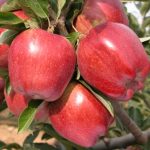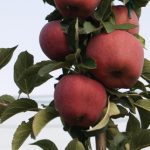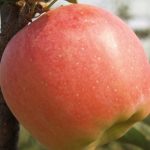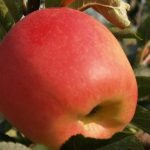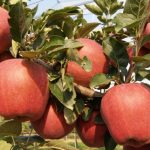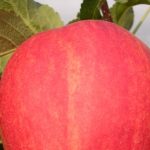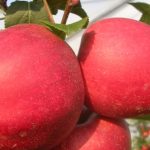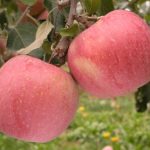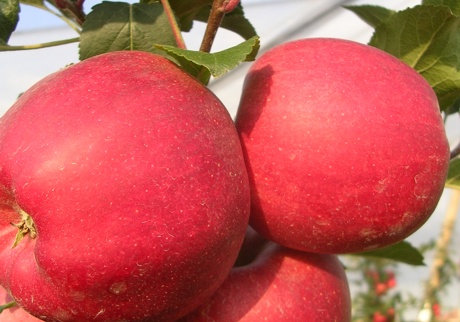
Name
Red Apple
Seal of quality

Typical food-farming product
Description
The apple “Mela Rossa Cuneo”, is characterised by overcolouring of the peel and particular bright and shiny shades of colour.
Here is a list of apple varieties and their clones deriving from a strict quality selection of the varieties still grown today, which are the only ones that can boast the protected geographic protection seal “Mela Rossa Cuneo”, and a description of their characteristics:
Red Delicious

Deep brilliant red epicarp, with extension of over-colour exceeding 85% of the entire surface, free of greasiness or roughness, tolerated only inside the peduncular cavity, an elongated conical trunk shape, 65 mm minimum diameter, sugar content over 10° Bx, white or creamy white pulp, dissolving texture, fragrant and sweet.
Gala

Brilliant deep red epicarp with extension of over-colouring exceeding 65% of the entire surface and distribution mainly streaked, smooth; a round stretched shape, 65 mm minimum diameter, sugar content over 12° Bx, creamy white pulp, crispy and juicy, fine and supple texture, extremely fragrant.
Fuji
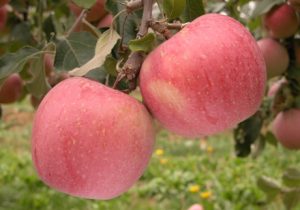
Light green – yellow epicarp, with overcolouring from light to deep red over more than 50% of the surface, 70 mm minimum diameter, sugar content over 12.5° Bx, pulp hardness 5 Kg/cm 2 . The pulp is crispy, juicy and extremely sweet but not aromatic.
Braeburn
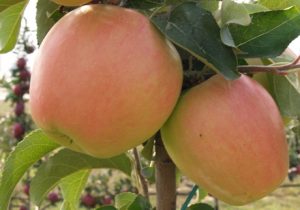
Epicarp from green to light green with streaky overcolouring from orange-red to deep red over more than 60% of its surface, 65% minimum diameter, sugar content over 10.5% Bx, minimum pulp hardness 5 .5 Kg/cm 2. Crispy, juicy, acidulous and extremely aromatic.
Nutritional characteristics
Due to its high and balanced composition of vitamins and mineral salts, the apple is the dietary supplement par excellence. The high presence of polyphenols – antioxidant agents that fight free radicals – help to slow down the cell ageing process, and various illnesses such as those related to the cardiovascular system and to cancer formation.
| FOOD | unit of measurement | Mele fresche con buccia | Mele fresche senza buccia |
|---|---|---|---|
| Edible part | % | 85 | 79 |
| Water | g | 85,2 | 82,5 |
| Protein | g | 0,2 | 0,3 |
| Fat | g | tr | 0,1 |
| Carbohydrates | g | 10 | 13,7 |
| Starch | g | 0 | tr |
| Soluble sugar | g | 10 | 13,7 |
| Total fibre | g | 2,6 | 2 |
| Energy | kcal | 38 | 53 |
| Kilojoules | kJ | 161 | 224 |
| Sodium | mg | 2 | |
| Potassium | mg | 125 | |
| Iron | mg | 0,3 | |
| Calcium | mg | 7 | |
| Phosphor | mg | 12 | |
| Thiamine | mg | 0,02 | |
| Riboflavin | mg | 0,02 | |
| Niacin | mg | 0,3 | |
| Vit A ret. eq. | mcg | 8 | |
| Vit C | mg | 6 | |
| Vit E | mg |
Area of production
The area of production can be identified on the tableland which extends along the Maritime and Cottian Alps, at an altitude ranging from 250 to 800 metres a.s.l., including in particular, in the province of Cuneo , the Saluzzo, Cuneo and Monregalese communes and, in the province of Turin , the communes of Pinerolo.
History
Apple growing in Piedmont has an ancient tradition, lost in the mists of time. Many cultivars were already imported to this region as far back as in Roman times.
However, the first signs of genuine fruit growing are found in the gardens and vegetable gardens of abbeys and convents. In fact, apple growing was first developed by the Clunac monks and later by the Cistercians, who worked hard to improve the varieties of the Roman period, which had survived all the barbaric invasions (Genesy A.,1892; Haussmann G.,1931; Mattirolo O.,1917).
The first cultural techniques appeared in the late medieval ages. The “pomes” were no longer food for the elite and, very soon, they spread to the other social classes. (Carlone R.., 1955) .
In the communal statutes and statements of the Savoy Lords of the manors, there was more and more mention of fruit trees planted alongside cultivated land, on open or closed fields, cornfields, vegetable gardens, brolii (tree-planted vegetable gardens), gardens, farmyards, vines. There began to be mention of planterii or, more specifically, of pomerii. The apple tree was beginning to be protected by the local authorities and became one of the most important fruit trees, dominating in Piedmont and in the Cuneo region in particular.
Fruit growing boosted during the Rennaisance, thanks to the circulation of papers and the first articles on agriculture.
Then, at the end of the 18th century, when farmers were crossing the Alps in search of work, they began to import new seeds, varieties and methods of implantation and pruning, which were already noted in France . This marked the beginning of Piedmontese fruit growing. An important contribution to increasing research and studies on culture practices came from the “Accademia di Agricoltura”, founded in 1785 in Turin , by experimenting on new species and organizating courses on fruit cultivation to begin preparing professional fruit growers.
Important for the diffusion of Piedmontese fruit growing were, in 1800, the nurseries of the Burdin brothers in Chambery . Even a pomological museum was set up in these nurseries, in which every type of fruit grown in the Royal States is preserved, predominantly the apple varieties, numbering as many as 72, classified and present also in the collection of the “Accademia di Agricultura” in Turin.
At the beginning of the 20th century, the area of cultivation, from the alpine valleys to the Piedmont areas, extended to the tablelands of Cuneo . The productive vocation of this region for red apples is proven by the vast range of local red-peel varieties that originated here spontaneously (Bounous G.,1980; Breviglieri N.,1950; Carlone R.,1955) .
Thanks to the consumers’ approval and the vicinity of the markets, this ample range of varieties maintained its high position until the modern red-peel varieties appeared on the scene at the beginning of the 20 th century, with which it became possible to satisfy even wider markets and, more important, markets further away.
The “Consorzio per la valorizzazione e tutela della Mela Rossa Cuneo ” was founded for this purpose, based in Cuneo, Via Bruni 5.
